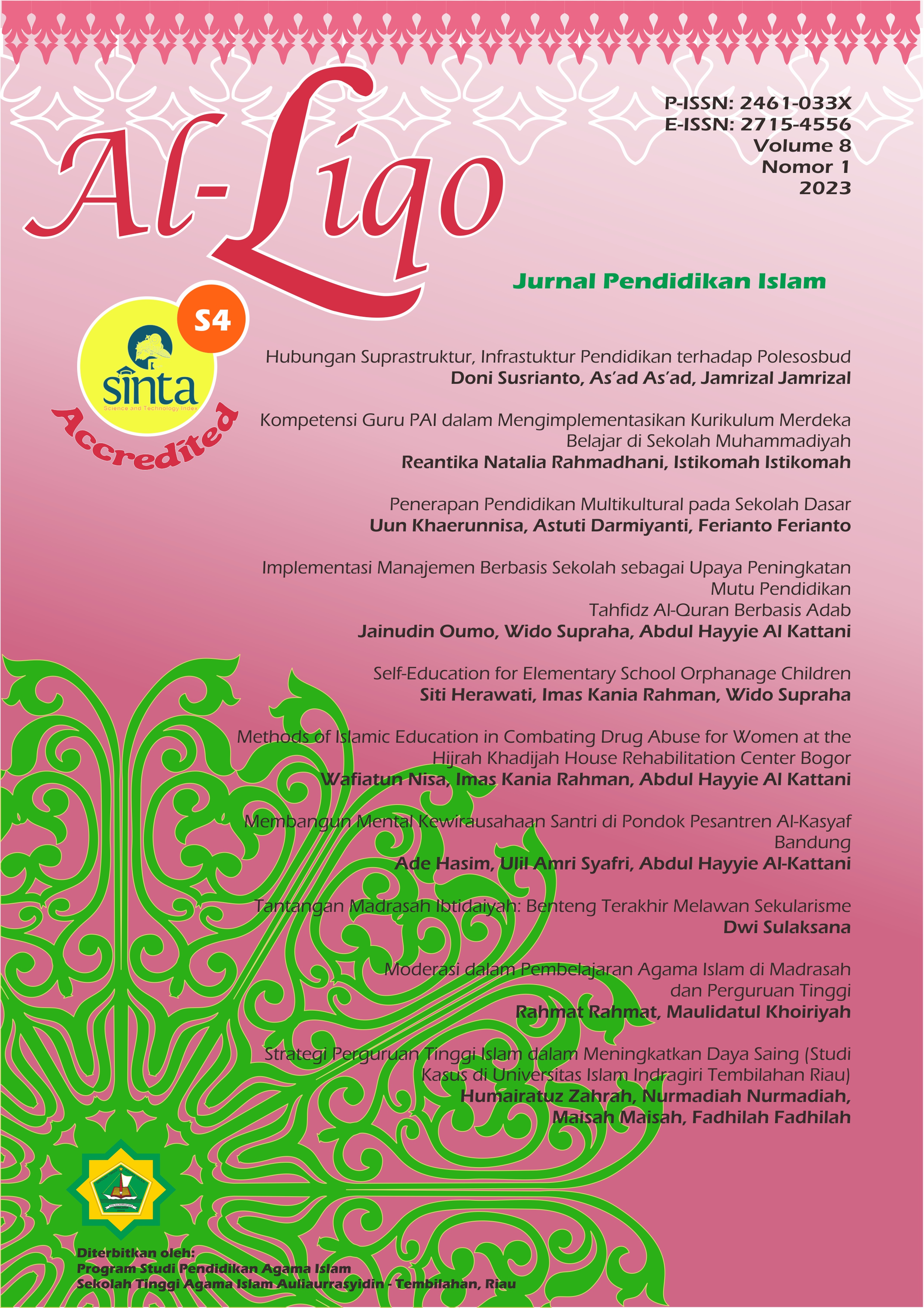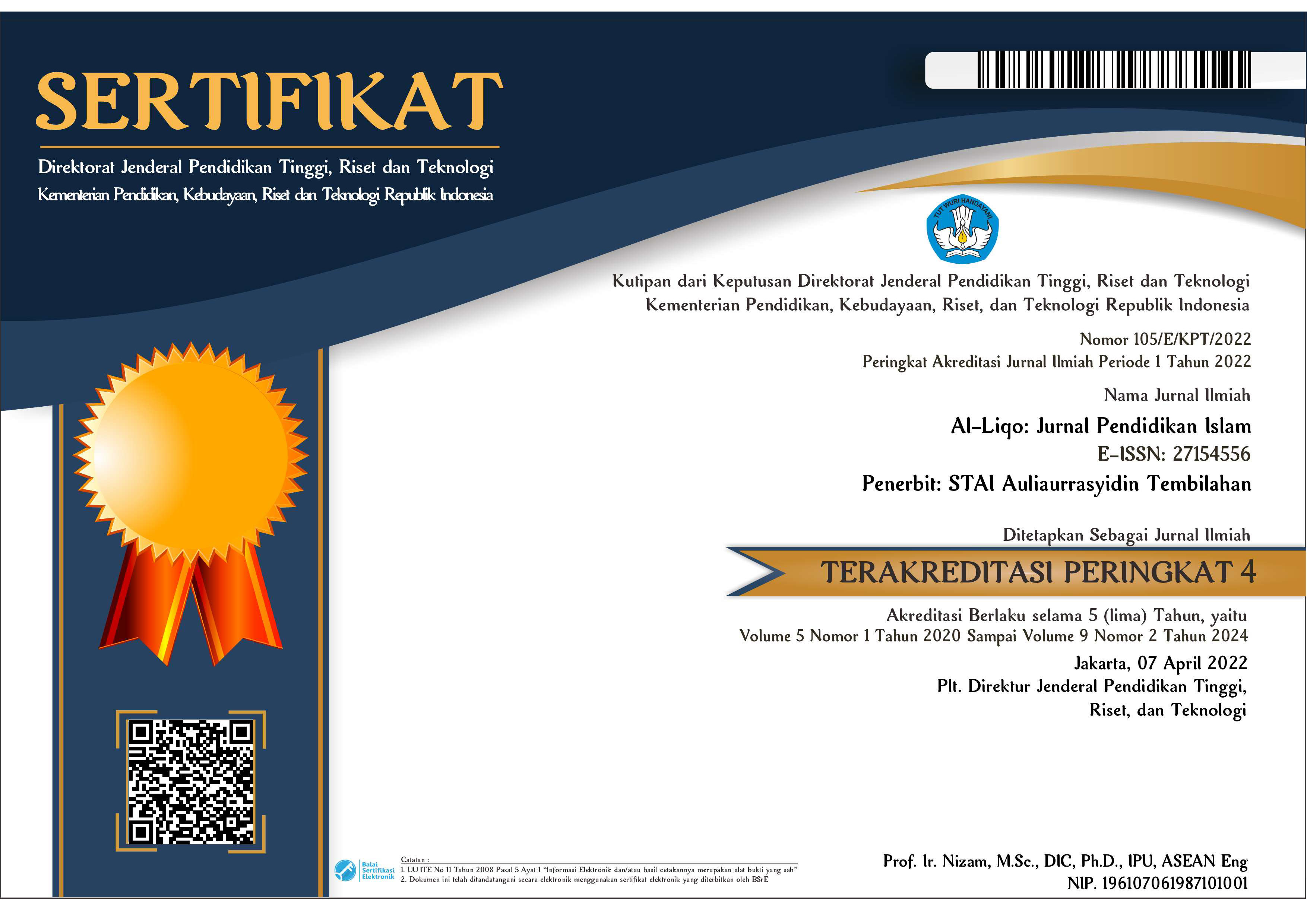Hubungan Suprastruktur, Infrastuktur Pendidikan terhadap Polesosbud
DOI:
https://doi.org/10.46963/alliqo.v8i1.1121Keywords:
Infrastructure, Superstructure, PolisosbudAbstract
The Unitary State of the Republic of Indonesia is a country rich in natural and cultural resources, stretching from Sabang to Merauke with national borders. The aim of the research is to find out the state of Polisosbud, superstructure and infrastructure of Islamic education and the influence of the development of Polisosbud on Islamic education. The research method uses a qualitative approach and observation techniques, interviews and documentation. The results of the study show that with the development of Polisosbud 2021, the cultural development index can provide a more comprehensive picture, covering 7 dimensions, namely cultural economy, education, socio-cultural resilience, cultural heritage, cultural expression, literacy culture and gender equality. Polisosbud superstructure and educational infrastructure are 3 things that are closely related and influence each other, meaning that education contains elements of Polisosbud. Polisosbud activities related to educational aspects. Polisosbud influences educational resources in the form of teacher salaries, learning support infrastructure and training. One of the most important contributions in the formation of meaningful learning is the presence of professional teachers.
Downloads
References
Abdulloh Hasyim, Komunikasi Politik Media Pendapat Umum & Perubahan Ruang Politik. Bandung: UIN Sunan Gunung Djati.
Abdulloh, M.Q. (1996). Teori Komunikasi Media Massa.
Bambang Sunggono. (1996). Metode Penelitian Hukum. Yogyakarta: Pustaka Pelajar.
Budiardjo, Miriam (2008). Dasar-dasar Ilmu Politik. Jakarta : PT. Gramedia Pustaka Utama
Jhon Eka Powa, As’as, Jamrizal, (2023). Pengaruh Perkembangan POLESBUD Terhadap Penataan Suprastruktur dan Infrastruktur. Journal of Social Science Riserch.
Muhammad Kambali, (2020). Pemikiran Karl Marx tentang Struktur Masyarakat (Dialektika Infrastruktur dan Suprastruktur). Jurnal Al-Iqtishod: Jurnal Pemikiran dan Penelitian, Vol 8 No.2.
RJ Kodoatie, (2005). Pengantar Manajemen Infrastruktur. Yogyakarta: Pustaka Pelajar.
Ramayulis, (2006). Ilmu Pendidikan Islam. Jakarta: Kalam Mulia.
R. Panuju, (2010). Jago Lobi dan Negosiasi. Jakarta: Interprebook.
Soemardi dan Reini D, (2009), Pembangunan Infrastruktur Untuk Semua. Bandung: Prosiding Seminar Nasional.
Suyanto, Lias Hasibuan dan Kasful Anwar Us. Konsep Dasar Ekonomi Pendidikan Pada Tataran Suprastruktur dan Infrastruktur Politik di Indonesia. Jurnal Manajemen Pendidikan dan Sosial (JMPIS). UIN STS Jambi 2023.
Syarifah, Ainun Hasibuan. (2020). Kajian Pengaruh Infrastruktur Terhadap Pertumbuhan Ekonomi Di Kota Pekanbaru. R epository uir.ac.id
Wahid U, (2016). Komunikasi Politik Teori Konsep Pada Era Media Baru. Bandung: Simbiosa Rakatama Media.
https://nasional.kompas.com/read/2022/08/23/03080021
https://nasional.kompas.com/read/2022/08/23/03080021
https://dinastirev.org/public/journals/3/pageHeaderLogoImage_en_US.png( 16-12-2022)
Monica Ayu Caesar Isabela | Editor Nibras Nada Nailufar KOMPAS.com.https://nasional.kompas.com/read/2022/02/01/01000051/suprastruktur-dan-infrastruktur-politik-indonesia.
https://dinastirev.org/public/journals/3/pageHeaderLogoImage_en_US.png
Downloads
Published
Issue
Section
License
Copyright (c) 2023 Doni Susrianto, As’ad As’ad, Jamrizal Jamrizal

This work is licensed under a Creative Commons Attribution-ShareAlike 4.0 International License.
Authors who publish with this journal agree to the following terms:
1. Copyright on any article is retained by the author(s).
2. The author grants the journal, right of first publication with the work simultaneously licensed under a Creative Commons Attribution shareAlike 4.0 International License that allows others to share the work with an acknowledgment of the work’s authorship and initial publication in this journal.
3. Authors are able to enter into separate, additional contractual arrangements for the non-exclusive distribution of the journal’s published version of the work (e.g., post it to an institutional repository or publish it in a book), with an acknowledgment of its initial publication in this journal.
4. Authors are permitted and encouraged to post their work online (e.g., in institutional repositories or on their website) prior to and during the submission process, as it can lead to productive exchanges, as well as earlier and greater citation of published work.
5. The article and any associated published material is distributed under the Creative Commons Attribution-ShareAlike 4.0 International License







2.png)



